An Unlikely Quartet from Comixology Submit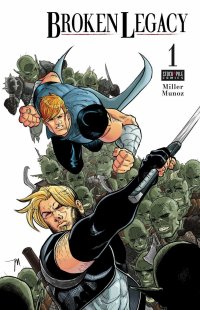
by Graig Kent
I’m still adjusting to becoming a digital reader. My preference still is — and will likely always be — physical copies, but digital has changed the landscape in so many ways it’s impossible to ignore. Digital has changed availability and accessibility, both for the reader, and the creator. Comixology’s “Submit” program for independent creators has further opened up channels for new and even established creators to release their self-published and boutique press book on the most widely used web and mobile comics platform. It’s been wildly popular with creators since its debut last year, this week alone sees 76 new issues being released, with the majority of them being first issues. Since there’s such a relentless stream of new and notable product coming out of the mainstream that makes it difficult enough staying on top of, it’s too easy to avoid or ignore indie product unless it explodes. While I’ve by no means waded through all of the released books this week, here are a few of the standouts:
I think soon many of the Submit books will start off like Broken Legacy #1 (Stock*Pile Comics, $0.99), as Kickstarter (or IndieGoGo) projects, if they aren’t already. In the backmatter creators Rian Miller and Jesse Munoz breeze through their 9 year journey in making Broken Legacy, from a high-school response to the stimulation of seeing Lord of the Rings for the first time, to a Kubert School side project, to failed pitches to publishers, to a rekindling during a long-distance jam night. The result is a mighty fine looking book in black and white with zip tones, Jesse Munoz showing a strong character design sense with a striking Chris Bachalo feel. The story is a little less immediate, about a pair of heroic brothers challenging the medieval establishment that killed their father years ago. My main issue with the story is its lack of clear focus. The brothers interfere with a raid on a village, but it’s left to the reader to suss out why they’re there or what the purpose of the raid is. With the focus so intent on the action sequence (between one brother and a mountain of a man) it lessens the importance of what the brothers are actually fighting for. The opening flashback, taking us to the brothers’ childhood and the moment of their father’s death is a solid sequence, but the impact of it doesn’t resonate beyond those opening pages.
Rating: 




Out of a Possible 5 Stars
 Death Trip (Tales To Suffice, $0.99), on the other had, may be more crudely illustrated, but its wicked sense of humor and engaging, off-kilter plot help get past that with ease. It’s the future, science has cured every ailment known to humanity, and in the process life expectancy has surpassed 200 years. In creator Kenny Keil’s future, he glosses over any societal/economical impact of a civilization with such a prolonged lifespan, instead it’s just accepted that society adjusts, except there’s the boredom. Enter “Peak Life” a company that offers a virtual reality-assisted suicide, a fantasy death where you can die doing the most insane thing you can imagine, guided by your Peak Life Agent. The most successful of these agents is Dominic Green, fully devoted to his career, the toll is starting to take effect. Sleep is rarely an option, and one drug counterbalancing the other seems to be the only thing keeping him going. At home the ghosts of the people he helped die haunt him, but casually so, and the strain of it all is starting to break him. Keil’s wry script sets up a preposterous reality that is quickly accepted (the breakdown on the title page actually does most of the heavy lifting), jumping straight into a death trip with a saggy, elderly woman making her horrifying Evel Knievel fantasy come true. Kiel’s art is not the most elegant, adopting a Kevin O’Neill/John McCrea aesthetic, but it’s quite effective and the storytelling works very well, with clever panel design that accentuates the satirical nature of the story. Beneath a cheeky Vertigo homage cover, this one’s a real winner.
Death Trip (Tales To Suffice, $0.99), on the other had, may be more crudely illustrated, but its wicked sense of humor and engaging, off-kilter plot help get past that with ease. It’s the future, science has cured every ailment known to humanity, and in the process life expectancy has surpassed 200 years. In creator Kenny Keil’s future, he glosses over any societal/economical impact of a civilization with such a prolonged lifespan, instead it’s just accepted that society adjusts, except there’s the boredom. Enter “Peak Life” a company that offers a virtual reality-assisted suicide, a fantasy death where you can die doing the most insane thing you can imagine, guided by your Peak Life Agent. The most successful of these agents is Dominic Green, fully devoted to his career, the toll is starting to take effect. Sleep is rarely an option, and one drug counterbalancing the other seems to be the only thing keeping him going. At home the ghosts of the people he helped die haunt him, but casually so, and the strain of it all is starting to break him. Keil’s wry script sets up a preposterous reality that is quickly accepted (the breakdown on the title page actually does most of the heavy lifting), jumping straight into a death trip with a saggy, elderly woman making her horrifying Evel Knievel fantasy come true. Kiel’s art is not the most elegant, adopting a Kevin O’Neill/John McCrea aesthetic, but it’s quite effective and the storytelling works very well, with clever panel design that accentuates the satirical nature of the story. Beneath a cheeky Vertigo homage cover, this one’s a real winner.
Rating: 




Out of a Possible 5 Stars
Promoted as “the ULTIMATE homage to 80’s action movies” and featuring a painted cover mocked up to look like a 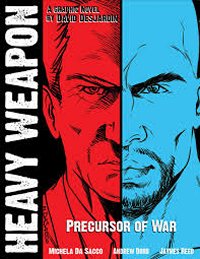 well-worn poster (with Terry Crews imagined in the lead role), I was anticipating more of a cheeky, over-the-top nudge-nudge-wink-wink action fable. While there were a few winks (like the character names of Magnum, McClane, Willis, Richter, etc), what is so surprising about Heavy Weapon: Precursor of War (Strike Comics, $3.99, also available in hardcover and paperback) is how earnest an action movie it is. The script from David Desjardin is mired in the cliches of Rambo, Commando, and the like, veteran tough-guy soldiers going back into action for a mission only they can handle. Desjardin’s story is an honest-to-gosh page turner that appeals both as an homage and on its own merits of character. Action movies have changed a lot since the 1980’s, but with artists Michela Da Sacco and Andrew Dodd, Desjardin looks back to those practical firefights, traps and explosions in simple settings full of expendable bad guys. There’s definitely love for the genre oozing out of this book. Beneath exceptionally fluid storytelling, Da Sacco and Dodd’s figures can be stiff at times, and there’s an unevenness to the characters throughout, but the fundamentals are there and they strengthen as the story progresses. Heavy Weapon really did hit the rhythms of a 80’s action flick perfectly, but small touches like character narration still make it feel like it’s meant to be a comic book and not just storyboards. By the closing credits (and there are closing credits) I was ramped up and ready for the next John Magnum adventure, and there’s definitely a sequel dangling in the midst of the conclusion, it’s a satisfying ride through and through.
well-worn poster (with Terry Crews imagined in the lead role), I was anticipating more of a cheeky, over-the-top nudge-nudge-wink-wink action fable. While there were a few winks (like the character names of Magnum, McClane, Willis, Richter, etc), what is so surprising about Heavy Weapon: Precursor of War (Strike Comics, $3.99, also available in hardcover and paperback) is how earnest an action movie it is. The script from David Desjardin is mired in the cliches of Rambo, Commando, and the like, veteran tough-guy soldiers going back into action for a mission only they can handle. Desjardin’s story is an honest-to-gosh page turner that appeals both as an homage and on its own merits of character. Action movies have changed a lot since the 1980’s, but with artists Michela Da Sacco and Andrew Dodd, Desjardin looks back to those practical firefights, traps and explosions in simple settings full of expendable bad guys. There’s definitely love for the genre oozing out of this book. Beneath exceptionally fluid storytelling, Da Sacco and Dodd’s figures can be stiff at times, and there’s an unevenness to the characters throughout, but the fundamentals are there and they strengthen as the story progresses. Heavy Weapon really did hit the rhythms of a 80’s action flick perfectly, but small touches like character narration still make it feel like it’s meant to be a comic book and not just storyboards. By the closing credits (and there are closing credits) I was ramped up and ready for the next John Magnum adventure, and there’s definitely a sequel dangling in the midst of the conclusion, it’s a satisfying ride through and through.
Rating: 




Out of a Possible 5 Stars
 When you go diving into the digital pit of self-publishing, you find a lot of genre riffs and superhero knock offs. I don’t mean to belittle anyone’s work, but just as with the mainstream there are piles of mediocrity and more piles of even worse. But there’s also gems like Jennifer Wilde in the mix, the first issue hitting Comixology Submit this week (Atomic Diner, $0.99). Set in 1920’s Paris, Jennifer Chevalier is an accomplished artist, whose strained relationship with her parents only exacerbates when her father turns up dead in the street where they’re supposed to meet, having “accidentally fallen” in front of a car. In reconciling his affairs, she comes across his locket containing her picture and that of Oscar Wilde. She attempts to summon her father’s ghost (a skill she discovered — then hid — as a child) but Wilde, her father’s former lover, appears instead and together they dig into the dead man’s past. It’s a strange twist, the ghost angle, but the script from Maura McHugh handles it effortlessly and nonchalantly. It’s a scenario explored minimally by a curious Wilde, but it’s obvious Jennifer is experienced in these types of encounters and is even able to speak to the ghosts subconsciously. The main focus of this first issue is how Jennifer deals with her mother with regards to her father’s past. It’s an exploration of how homosexuality was looked upon in the era, and how it affected marriages and relationships, without ever putting too fine a point on it. Beyond these wonderfully juxtaposed touches of supernatural and social, McHugh captures the sharpness of Wilde with some great wordplay and observations. The characterization of Wilde, going into this, was the part that had me the most reticent but it’s truly handled well. The art of Jennifer Wilde is the standout attraction of an already great book. Stephen Downey’s art is beautiful, with impeccably designed characters and richly realized settings, all softly shaded (I can’t quite tell if it’s ink washes or pencil shade or both) giving incredible depth in black and white.
When you go diving into the digital pit of self-publishing, you find a lot of genre riffs and superhero knock offs. I don’t mean to belittle anyone’s work, but just as with the mainstream there are piles of mediocrity and more piles of even worse. But there’s also gems like Jennifer Wilde in the mix, the first issue hitting Comixology Submit this week (Atomic Diner, $0.99). Set in 1920’s Paris, Jennifer Chevalier is an accomplished artist, whose strained relationship with her parents only exacerbates when her father turns up dead in the street where they’re supposed to meet, having “accidentally fallen” in front of a car. In reconciling his affairs, she comes across his locket containing her picture and that of Oscar Wilde. She attempts to summon her father’s ghost (a skill she discovered — then hid — as a child) but Wilde, her father’s former lover, appears instead and together they dig into the dead man’s past. It’s a strange twist, the ghost angle, but the script from Maura McHugh handles it effortlessly and nonchalantly. It’s a scenario explored minimally by a curious Wilde, but it’s obvious Jennifer is experienced in these types of encounters and is even able to speak to the ghosts subconsciously. The main focus of this first issue is how Jennifer deals with her mother with regards to her father’s past. It’s an exploration of how homosexuality was looked upon in the era, and how it affected marriages and relationships, without ever putting too fine a point on it. Beyond these wonderfully juxtaposed touches of supernatural and social, McHugh captures the sharpness of Wilde with some great wordplay and observations. The characterization of Wilde, going into this, was the part that had me the most reticent but it’s truly handled well. The art of Jennifer Wilde is the standout attraction of an already great book. Stephen Downey’s art is beautiful, with impeccably designed characters and richly realized settings, all softly shaded (I can’t quite tell if it’s ink washes or pencil shade or both) giving incredible depth in black and white.
Rating: 




Out of a Possible 5 Stars
AVENGERS #25 (Marvel $3.99)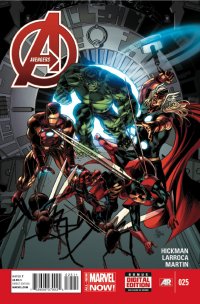
By Cat Taylor
In case you were just rescued from a desert island and haven’t heard, Marvel is attempting to attract new readers again by adding “.Now” to their entire line of comics for the issue that is supposed to be a perfect “jump aboard” point for new readers. The previous issue of Avengers was the first of the “.Now” line for the Avengers. However, don’t worry if you didn’t read it. The only significant plot point is recapped on the first page of this issue, and if you aren’t already familiar with this incarnation of the Avengers, the previous issue won’t bring you up to speed any more than this one will. So, whether you’ve been buying the Jonathan Hickman run of the Avengers or whether you haven’t, you’ve no more to gain or lose by starting here than you would have with the previous issue. So much for the significance of “.Now.”
There has been a lot of excitement around Jonathan Hickman’s writing of the Avengers’ titles, but I have mixed feelings after the first 25 issues of the central Avengers book. On one hand, he really has made the Avengers a bigger and more important team than they have been under other writers. This really does feel like a team of “Earth’s Mightiest Heroes” tackling only the biggest of problems. On the other hand, his approach isn’t as fun to read because so far he’s made things overly cosmic and pseudo-intellectual. The other reservation I have with Hickman’s Avengers is that the team is too big to focus on the individual members. I know he’s tried to combat that over the past several issues with alternate stories focusing on the backgrounds of the less established characters but it still feels like an army of robots rather than individual characters who have come together.
This issue is the first one since Hickman took over that shows the potential to use the pros of Hickman’s approach and minimize the cons. Rather than a huge cosmic event that requires all the two dozen or so Avengers in full-scale combat, this new story arc centers around an object in A.I.M.’s possession that can access multiple times, universes, dimensions, etc. While it appears that the full capabilities of this object have yet to be explained, the A.I.M. scientists talk about it like it may be on a power scale with the Cosmic Cube. Although we don’t see that kind of power demonstrated in this issue, we do see it used as a multiverse, time travel “fishing pole”.
It’s hard to discuss the details of what A.I.M. extracts from the multiverse and how it could be an “Avengers-worthy” challenge without getting into spoiler territory, which would ruin the fun for anyone who hasn’t already read this issue, but it’s a pretty “big fish”. What I will say is that, on the positive side, this new challenge could meld the best of Hickman’s cosmic-scale approach with the best of the previous writer, Brian Michael Bendis’s character-driven approach. On the negative side, this new story arc already appears to have a lot in common with a recent DC comics event.
It will be interesting to see where the story goes from here. As a regular buyer of the Avengers, I’m on board either way. Needless to say, I’m hoping to see an interesting story worthy of the reputation Hickman established during his run on Fantastic Four, and not a retread of a recent DC comics multi-title event.
Rating: 




Out of a Possible 5 Stars
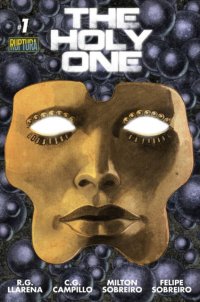 The Holy One #1 ($0.99 on Comixology, Ruptura)
The Holy One #1 ($0.99 on Comixology, Ruptura)
by D.S. Randlett (@dsrandlett)
I’d like to think that I’m a somewhat discriminating comics buyer, unchained from any kind of nostalgia or irrational habit. This isn’t true of course. I will buy nearly anything with Superman in it, and for most of 2013 this was like holding my hand on a hot stove. I will buy nearly anything with Nightcrawler in it, which is why I wait raptly each month for the next exceedingly mediocre issue of Amazing X-Men. Finally, I will also buy pretty much anything that looks like it could have been published by Les Humanoides Associees in the seventies and eighties. That last one is a much more recent prejudice, brought on by finally reading The Metabarons about three years ago. It had been one of those things that I had been putting off, but once I jumped in, there was no looking back. Reading Jodorowsky (and it must be said, his various incredible artistic partners)at his best is, for me, like like hanging out with a crazy uncle who is on a whole different plane of existence but nonetheless totally gets you. I loved the kooky spiritualism, the operatic dialog, the black as night humor, and the assorted SF tomfoolery and badassery.
So when I see a cover staring from the (digital in this case) racks that could come straight from those hallowed days, I’ve got to pick it up. The Holy One wears its influences on its sleeve (hardly surprising as all of these guys have apparently worked on Heavy Metal in the past), but doesn’t quite have the same feel as Jodorowsky’s work. The drawback to this is that the script isn’t as deliriously bonkers, but the upshot is that the story and ideas are a bit more grounded and comprehensible. Writers C.G. Campillo and R.D. Llarena have their eyes on some pretty big themes here, but they haven’t really unfolded themselves. As a narrative, this is a first issue that feels like the first 32 pages of a graphic novel. The Holy One is obviously incomplete, but nonetheless compelling. A city leaves behind peace, and an obviously non-human healer arises in a small village on the city’s outskirts, which threatens the godlike entity at the center of the city’s power. Religion is an obvious theme here, as is imperialism, and it should be fun to see how this series finishes this particular train of thought. Beyond that, there are some really cool scifi ideas on display.
These are brought to life in The Holy One by the phenomenal art by Milton and Felipe Sobreiro. It has the look of watercolored pencils, much like Juan Gimenez’s art in The Metabarons, but the line work here isn’t quite so delicate as that. The linework here is a bit thicker, recalling the Conan work of Cary Nord, but the feel is very European. The art struggles a bit when conveying “small moment” like a picnic that takes place at about the halfway point, but the imagery in the chambers of The City’s patriarchy and the otherworldly abilities of The Holy One are absolutely indelible. The style pushes nothing forward, but it knows what it is and does that very, very well.
This is an easy first issue to recommend, as pretty much everything is on point. If they follow through and stick the landing, I’ll be telling everyone I know to read The Holy One.
Rating: 




Out of a Possible 5 Stars
A Boom Shanka! Special
Hacktivist #1 (Archaia, 3.99)
The Midas Touch #1 & #2 (Boom! Box, $3.99)
By Adam X. Smith
This week’s comic reviews are courtesy of Boom! Studios.
A while ago I did a couple of video blogs here talking about how certain comic book companies were similar to film studios, and I talked a little about how up-and-coming companies like Boom! Studios, compared with their seasoned counterparts like Dark Horse or Image, are sort of like the Amazon and Netflix of their medium: young, ambitious, but lacking the brand recognition necessary to punch through into the mainstream. Saying that, I also compared Image to the now-defunct United Artists, and to their credit they have had some good stories on their roster, so clearly I’m not right about everything.
Back to Boom! Studios, though. In our capacity as internet comic book reviewers for CHUD, we are given access to 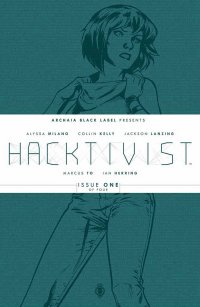 free comics (not many, but some) via digital platforms for the benefit of publicity. Apart from giving lesser known books much-needed exposure – something I’m always happy to do – it also means that I can put out a column on weeks when I’m either broke or nothing else particularly interesting is being released. So, without further yammering, a few choice selections from Boom! Studios’ selection, as recommended by my esteemed colleagues. First up, Hacktivist from recent Boom! subsidiary, Archaia Press.
free comics (not many, but some) via digital platforms for the benefit of publicity. Apart from giving lesser known books much-needed exposure – something I’m always happy to do – it also means that I can put out a column on weeks when I’m either broke or nothing else particularly interesting is being released. So, without further yammering, a few choice selections from Boom! Studios’ selection, as recommended by my esteemed colleagues. First up, Hacktivist from recent Boom! subsidiary, Archaia Press.
Just because I have to address it somehow right off the bat, Hacktivist was “created” by Alyssa Milano, formerly of Charmed. However, her credit on the issue – while probably representing a story influence and possibly permission to use her likeness – carries no more weight than Christopher McQuarrie’s name does on Archaia’s graphic novel Rubicon – it’s just the brand name that gets bums on seats while house writers and artists do the heavy lifting (in this case, Jackson Lanzing and Collin Kelly on scripting and Marcus To on art).
The plot is a little bit The Social Network (dot-com millionaires, one a douchebag extrovert with impulse control issues, the other an OCD introvert obsessed with patterns, check), a little bit Now You See Me (incomprehensible technology, pseudo-anarchist principles, check) with a bit of topical Wikileaks/Arab Spring world events thrown in on top for good measure. The main difference is of course that the tech gazillionaires are actually pro-privacy, are actively trying to destabilise dictatorial regimes by giving people in Tunisia their internet back, and the CIA seems to want them on side. Hmm.
As hokey as that plot comes across on paper, and while the characters are so broadly written as to be almost parodic, this book does score points for having pretty good art. Marcus To manages to capture the texture of the Tunis uprising whilst still giving the scenes texture and life – all of which gets sucked away the second we go state-side and the colour palette immediately decided to stick mostly with blue-and-orange, as if we’ve been transported into a world where people only dress like they’re from a film or video game poster. And the cliffhanger, which involves the douchebag character doing some ridiculously complicated Gatsby-esque prank that involves him doing something with the lights in NYC (probably, it wasn’t entirely obvious from the art), comes off as just… meh, small potatoes. I mean, your the one that’s the scourge of despots? Some hipster dickhole in a tuxedo with a phone app that fiddles with the lights?
It goes to show that, even with the infinite freedom of expression that the comic book format allows for, you can’t make good storytelling appear out of nothing. That’s probably a little harsh – the book isn’t terrible, and since it’s a four-parter and not an ongoing, I’d probably read it again just to see if it gets its act together. It’s over-priced at $3.99, but for something that didn’t cost me a dime, you could do a lot worse. I’ll keep you posted if anyone else can summon any enthusiasm for it.
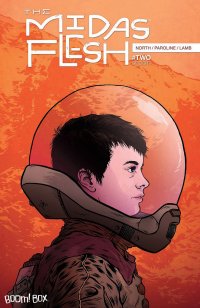 On the other side of the coin, we have The Midas Flesh, a series whose mission statement seems to be “give Adam X. Smith” what he wants: something to get excited about. You like space? You like Ancient Greece? How about talking dinosaurs? Well this book has all three.
On the other side of the coin, we have The Midas Flesh, a series whose mission statement seems to be “give Adam X. Smith” what he wants: something to get excited about. You like space? You like Ancient Greece? How about talking dinosaurs? Well this book has all three.
Courtesy of writer Ryan North and artists Shelli Paroline and Braden Lamb, we get a story about three spacers – a sassy female captain somewhere between Ellen Ripley and Mal Reynolds, an Arab girl called Fatima for a pilot, and Cooper, a talking raptor with a tie and glasses for a science officer. Yes, I can see you’re riveted, but stick with me – it gets better. In their trusty spaceship the Prospect, the crew flee the space government and arrive at a long dead planet, surrounded by a swarm of attack satellites. The planet is Earth, and 4,637 years earlier, the entire planet was turned to solid gold due to the miracle that occurred when a king by the name of Midas was struck by magical lightning. Because, you know – mythology.
Two issues in, we’ve already got lots of cool details about the universe – imagine Firefly if Joss Whedon had been on crack – that raises just enough questions to keep us interested: scientifically advanced dinosaur planets; a galactic community that includes humans (or humanoids, it’s not entirely clear) who are distinctly European and Asian in appearance without explaining where they came from considering Earth was sterilised by the Midas field millennia ago; and an overzealous Alliance military whom the characters are desperate to stay one step ahead of. Paroline and Lamb’s work reminds me of Darwyn Cooke in his prime (always a vote of confidence), and even at eight issues in length, the story doesn’t feel baggy. Kudos to North for getting the all-important balance of world/universe-building and character development spot on, giving us just enough to want more.
So yeah, mission accomplished, Boom! Studios. Your stock is rising. Boom Shanka!
Hacktivist #1 Rating: 




Out of a Possible 5 Stars
The Midas Flesh #1 & #2 Rating:





Out of a Possible 5 Stars
Deadly Class #1 (Image, $3.50)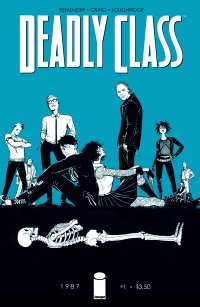
By Jeb D.
Being a sucker for comics set in San Francisco, and something of a spoiler-phobe, I grabbed up the first issue of Rick Remender and Wes Craig’s new series without any prior knowledge of the premise, and I’m not sure that was the right move: I think this is one case where I might have enjoyed this comic more if I’d gone in knowing a bit more about what I was getting.
In 1987 San Francisco, Marcus is a homeless teenager living rough. Remender and Craig don’t condescend or romanticize their portrait of street life: no reader is likely to get through the first few pages without some serious reflection on a system that fails to address this kind of misery. Remender provides Marcus with a nicely detailed backstory, and Craig (with appropriately stark-toned coloring from Lee Loughridge) brings an actual sense of “grit” to the proceedings: in other words, not “gritty” as a synonym for ponderously bad-tempered comic book storytelling, but conveying the sense of a subculture encrusted in dirt and/or excrement.
From this unusually realistic setting, with its vivid links of the City by the Bay’s past to its present, the reader might hope for something off the beaten track in terms of story material. Alas, by the time we get to the end of this issue, Remender and Craig’s verisimilitude seems to have been put at the service of a familiar story of a young hero being introduced to a world of strange powers to which he never knew he might belong: whether you favor Harry Potter, Wanted, or The Hobbit, you’ve read (or watched) the first issue of this series at least a dozen times over; it’s even possible to see the clear templates for much of the supporting cast (comic creators from Neil Gaiman to Mark Millar to Ed Brubaker are nodded to).
Remender’s notes in the backmatter stress the way that he’s using his own experiences of growing up as an outsider in frequently-violent environments to bring depth and texture to the storytelling: so far, he’s managed that in Marcus’ initial point of departure, but it’s difficult to determine whether this series (and Remender’s familiarly skewed approach to plotting) will use that to transcend its derivative roots, or whether the social points he seems to be making at the outset will serve as anything more than background as the series moves on. And, as I say, if you come to the book already knowing that some well-worn tropes will shape its framework, you may be less disappointed when they pop up.
There’s no question, though, that Craig’s fantastically laid-out work is going to make at least this first issue worth a trial purchase. Artists who are equally good at providing realistically sketched environments, innovative perspectives, and deliriously entertaining action sequences, are few and far between; Craig is right up there with David Aja and Matt Kindt in blending all those characteristics: this is the kind of visual storytelling that can lay a fresh coat of paint on what seems, so far, to be a rather derivative story.
Rating: 




Out of a Possible 5 Stars
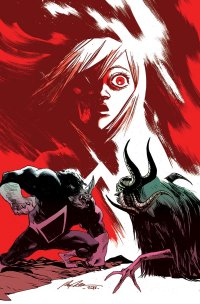 ANIMAL MAN #27 (DC $2.99)
ANIMAL MAN #27 (DC $2.99)
By Cat Taylor
When DC relaunched Animal Man as one of their “new 52” titles, I was impressed with how well they managed to capture the spirit of the classic Animal Man comics from the 1980s and 1990s. This was especially welcome considering that many of DC’s Vertigo line of offbeat titles were discontinued in order to merge them with their main “new 52” universe. So, before reading this issue of Animal Man, I decided to take a trip back in time and read an issue from Tom Veitch’s 1991 run on the title for comparison. The common thread with Veitch, Grant Morrison, and the early Jeff Lemire issues is that Animal Man is to DC Comics superheroes what David Lynch is to Hollywood movies. Animal Man is a costumed hero in the same world as Superman and Batman but his adventures aren’t usually battles with supervillains trying to take over the world, but rather surrealistic acid flashbacks. This metaphysical WTF approach is how Grant Morrison turned a C-list character into the most interesting mainstream DC superhero in their entire line. It’s an approach that Veitch continued and that Jeff Lemire revived with his “new 52” run. In addition, the current run of Animal Man has an appropriate artist in Rafael Albuquerque, who has a sketchy style that fits the frenetic, cartoonish energy of Lemire’s writing.
Since the relaunch of the title approximately two years ago, Lemire has acknowledged what the previous writers established while adding his own oddball supporting cast, new takes on Animal Man’s superpowers, and a nearly indescribable dimension called the “Red” that holds power over all of Earth’s animal life. Earlier issues have been the stuff of nightmares, have taken metaphysical angles, or included stories such as having Buddy Baker (Animal Man’s not-so-secret identity) star in a movie that’s basically a superhero take on the “Wrestler.”
Even though this issue is titled “Evolve or Die part 1”, it seems that Lemire is nearing the end of his run. Despite the previously established strange characters and environments, the story has reached a point where the surreal occurrences have largely been put aside and the main characters are now engaged in a big climactic battle for control of the “Red”, and consequently, Animal Man’s daughter, Maxine. As a result, this issue more than most other issues of Animal Man, reads like a fairly standard superhero comic. However, there is a LOT going on with the multiple characters in this issue. So, this may be a difficult issue for a new reader to pick up from scratch.
Rumor has it that Jeff Lemire is planning to end his run on this title in March and it certainly feels like things are winding up with in this issue. If that’s true and if you haven’t jumped on board so far, I’d recommend catching up through the trades and then joining the title for the next story arc. I hope when Lemire ends his run, that he leaves the title in a good place so another creative writer with a non-traditional approach like Morrison, Veitch, or Lemire gets to put his or her unique spin on Animal Man’s world. As long as someone has creative ideas for the series, Animal Man will remain a much-needed monkeywrench in the world of DC Comics.
Rating: 




Out of a Possible 5 Stars